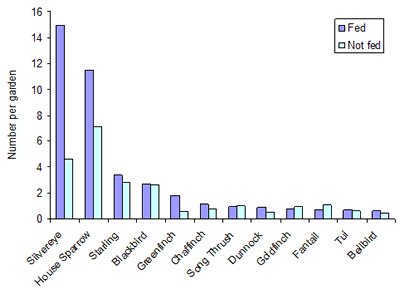2007 Results

Silvereye at feeder with bread. Image - H. Christophers
The first nationwide garden bird survey in New Zealand took place between 14 and 22 July 2007.
Participants spent one hour watching birds in their home gardens, local parks, or school grounds, recording the highest number o f individuals of each species seen at once. A total of 2064 valid survey forms were returned. Of these, 1954 were from home gardens, 78 from parks, and 32 from school grounds (including kindergartens and early childhood centres).
The silvereye was the species recorded in the greatest numbers in home gardens in 2007 (average 10.2 per garden). The house sparrow (average 9.4 per garden) was a close second, starling (3.1 per garden) a distant third, and blackbird (2.7 per garden) fourth. However, blackbird was the most widely distributed species, being present in 90% of home gardens, followed by house sparrow in 86%, silvereye in 81%, and starling in 61%.
Results from parks and school grounds were generally similar to home gardens, but there were more of some species such as ducks, gulls, rock pigeons, blackbirds, and song thrushes, and fewer of other species such as silvereyes and dunnocks.
Large number of species found
In total, 89 species of birds were detected: 86 in home gardens, 49 in parks, and 32 in school grounds. The number of species detected in home gardens was surprisingly large. However, home gardens ranged from truly urban to rural and seaside. Some people living in the country considered the surrounding farm paddocks as part of their garden and recorded species such as feral goose, wild turkey, pheasant, brown quail, and tufted guineafowl. Others considered the surrounding bush as part of their garden and recorded species such as falcon, red-crowned kakariki, rifleman, robin, tomtit, whitehead, and saddleback. Some people living on the coast overlooking the sea considered the sea as part of their garden and recorded species such as white-faced storm petrel, cape pigeon, gannet, white-fronted tern, black-fronted tern, Caspian tern, black-billed gull, wrybill, and various shags and herons.
Only 20 species were recorded in more than 10% of the surveys. On average, there were 7.6 species per home garden, 8.9 species per park, and 6.5 species per school ground. One participant recorded 24 species and two participants none during their one hour of observation.
Top ten species in New Zealand gardens
Only two native species (silvereye and fantail) featured in the top 10 birds in New Zealand gardens in 2007. The tui was 11th, bellbird 15th, kereru (kukupa or New Zealand pigeon) 18th, and grey warbler 21st. Eight of the top 10 birds in New Zealand gardens were introduced species, and five of these also featured among the top 10 birds in UK gardens in 2007.
The silvereye (also known as wax-eye or white-eye) was the species recorded in greatest numbers in New Zealand gardens in 2007 (average 10.2 per garden). Furthermore, it was detected in 81% of gardens, the third most widespread species. It was much more common in gardens where birds were fed than where they were not.
The house sparrow was the 2nd most abundant species recorded in New Zealand gardens (9.4 per garden) and most abundant in UK gardens (4.4 per garden) in 2007. Note that it was much more abundant in New Zealand gardens than in UK gardens. It was detected in 86% of New Zealand gardens, the second most widespread species. It was much more common in gardens where birds were fed than where they were not.
The starling was the 3rd most abundant species recorded in New Zealand gardens (3.1 per garden) and 2nd in UK gardens (3.7 per garden) in 2007. It was detected in 61% of New Zealand gardens, the fourth most widespread species. It was more common in gardens where birds were fed than where they were not.
The blackbird was the 4th most abundant species recorded in New Zealand gardens (2.7 per garden) and 3rd in UK gardens (2.3 per garden) in 2007. It was detected in 90% of New Zealand gardens, more than any other species, but because there was an average of only 2.7 per garden the total number of blackbirds was lower than for the three species above.
The greenfinch was the 5th most abundant species recorded in New Zealand gardens and 10th in UK gardens in 2007. Average numbers were the same in both countries (1.2 per garden). Greenfinches were detected in 24% of New Zealand gardens. They were much more common in gardens where birds were fed than where they were not.
The song thrush was the 6th most abundant species recorded in New Zealand gardens (0.98 per garden) but didn’t make the top 10 in UK gardens in 2007. It was detected in 52% of New Zealand gardens.
The chaffinch was the 7th most abundant species recorded in New Zealand gardens and 5th in UK gardens in 2007. Surprisingly, the species was less common in New Zealand gardens (0.95 per garden) than in UK gardens (1.9 per garden). It was detected in 36% of New Zealand gardens. It was more common in gardens where birds were fed than where they were not.
The goldfinch was the 8th most abundant species recorded in New Zealand gardens (0.87 per garden) and 11th in UK gardens in 2007. It was detected in 22% of New Zealand gardens. It is surprising it was not more abundant in gardens where birds were fed, but this may be an artefact of the number of rural versus urban gardens where it was detected.
The fantail was the 9th most abundant species recorded in New Zealand gardens (0.86 per garden) in 2007. It was detected in 42% of gardens.
The dunnock (or hedgesparrow) was the 10th most abundant species recorded in New Zealand gardens (0.79 per garden) and 12th in UK gardens in 2007. It was detected in 28% of New Zealand gardens.
Home gardens
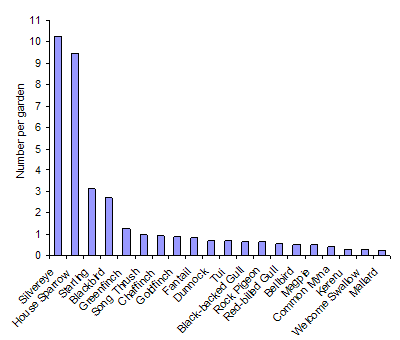 |
Average numbers of top 20 bird species detected at once in gardens, July 2007 Silvereyes were recorded in the greatest numbers (average 10.2 per garden). House sparrows averaged 9.4, starlings 3.1, blackbirds 2.7, greenfinches 1.2, and other species less than 1.0 per garden. In general, more birds were recorded in gardens where birds were fedthan where they were not. |
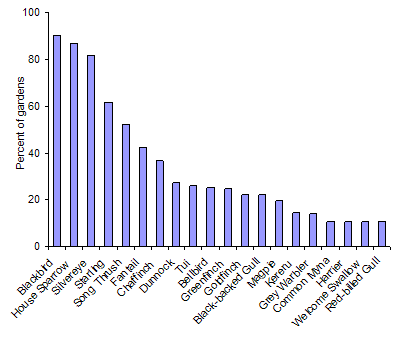 |
Percentage of gardens in which top 20 bird species were detected, July 2007 Blackbirds were the most widely distributed species, being present in 90% of home gardens, followed by house sparrows in 86%, silvereyes 81%, starlings 61%, song thrushes 52%, and other species less than 50% of home gardens. |
Gardens where birds were fed |
|
|
|
Average number of birds detected in gardens where birds were fed compared with gardens where they were not, July 2007 In general, more birds were recorded in gardens where supplementary food was provided than where it was not. For example, there were 14.9 silvereyes per garden where birds were fed compared with 4.7 per garden where they were not fed. Similarly, there were 11.5 house sparrows per garden where birds were fed compared with 7.1 per garden where they were not fed. |
Sixty-eight percent of participants fed birds in their home gardens. This does not mean that 68% of households in New Zealand feed birds because people who feed birds are probably more likely to have participated in the survey than those who don’t feed birds.
Bread, fat, seeds, and fruit each comprised 20–24% of the food fed to birds, and sugar-water 11%. Other foods included food scraps, porridge, mashed potato, and cooked rice.
Silvereye
The largest numbers of silvereyes were from gardens where birds were fed sugar-water and fat. Carol Sawyer from Mosgiel had the highest count of silvereyes (200+). She put out 10 large bowls of sugar-water daily and the silvereyes “swarmed around them like bees”. They can drink 10 litres or more in a day. Pat Dobson from Waimate put out sugar-water and a fat/seed mixture (also fruit and bread) and also counted at least 200 silvereyes. She said silvereyes “love mashed potato with a little fat, and also love porridge”. Sue Holliday from Ashburton put out sugar-water, fat and fruit and had 150 silvereyes in her garden. She said the silvereyes also sought out nectar from flowering Eucalyptus, Grevillea, Correa, Melaleuca and other plants growing in her garden. She had plants flowering all year round. Myarie Fletcher, from Rangiora, put out 6 litres of sugar-water per day and counted 20–30 silvereyes during her survey, but said “there seems like a hundred about at all times.” Her garden is known as the “hundreds and thousands” garden because of the large number of birds she attracts (and also the large number of seedling plants she grows). Rona Horan from Leeston put out nine bags of rendered down fat mixed with wild bird seed and said there could be up to 10 silvereyes at each bag (she counted 60–70 at one time during her hour of observation). Silvereyes also eat bread.
Tui & bellbird
The largest numbers of tui and bellbirds were also from gardens where birds were fed sugar-water. One survey participant (Neville Campbell, Riverton) put out 2 litres of sugar-water daily in five locations around his garden and recorded 35 tui, 45 bellbirds, and 35 silvereyes. Another participant who put out sugar-water (Russell Mason, Pounawea) counted 48 tui and 40 silvereyes, though only 3 bellbirds.
Kaka
Richard McNair, Coromandel, had tui, bellbirds, silvereyes, and kaka come to his sugar-water feeder. He counted 27 tui, 23 silvereyes, 2 bellbirds, and 1 kaka during his hour of observation. He said, “The kaka came to the feeder every evening”. It also ate dates.
The record number of kaka comes from Stewart Island, where Susan Ford put out fat, fruit, and seeds for birds and had up to 24 kaka in her garden daily (although she recorded only 17 in the survey). Susan had some amusing stories to tell concerning kaka. One day while working in her kitchen there was a sudden downpour of rain outside, so she went to close the ranch-sliders in her living room, only to discover 17 kaka sitting on the floor and couch sheltering from the rain. Another time a kaka came inside at night and helped itself to nibbles laid out for dinner-party guests.
Feeding wild birds
Feeding of wild birds is controversial. I’ll add information on the pros and cons at a later date. However, in the interim I’d like to make a comment on feeding sugar-water. One survey participant used one part of sugar to two parts of water (33% concentration), and another used one part of sugar to three parts of water (25%). Birds will certainly appreciate these concentrations (generally the higher the concentration the more birds are attracted to the sugar-water) but the usually recommended concentration is one part of sugar to four parts of water (20%), and some people use one part of sugar to five parts of water (17%). Never use honey because it can spread bee diseases.
Parks
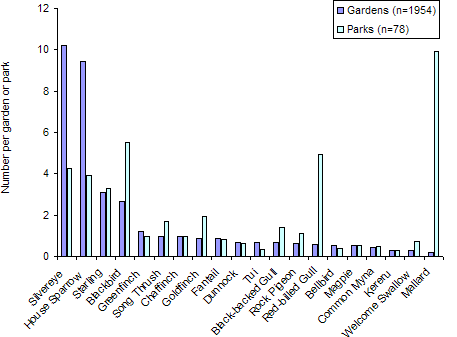 |
Average number of birds detected in parks compared with home gardens, July 2007 Results from parks were similar to home gardens. However, parks had fewer of some species such as silvereyes and house sparrows, and more of others such as blackbirds, song thrushes and goldfinches. They also had many more red-billed gulls and mallard ducks. Silvereyes and house sparrows are often fed in home gardens, and rock pigeons, red-billed gulls, and ducks are often fed in parks. |
Schools
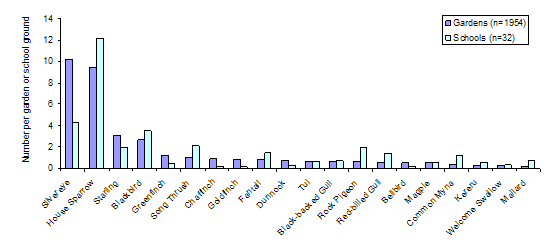 |
|
Average number of birds detected in school grounds compared with home gardens, July 2007 Results from school grounds (including kindergartens and early childhood centres) were similar to those from home gardens. However, school grounds had more of some species such as house sparrows, blackbirds and song thrushes, and also rock pigeons, red-billed gulls, and mallard ducks, and fewer of other species such as silvereyes, greenfinches, chaffinches, goldfinches, dunnocks, and grey warblers. |
The lower number of some species such as silvereyes may reflect the fact that most schools do not feed birds. The lower number of other species may indicate that school pupils did not know how to identify these species, or that the sample size (32) was too small. Grey warblers, for example, were not detected in any school grounds whereas they were detected in 14% of home gardens and 28% of parks. Twenty-four of the school grounds were surveyed by school children as a class exercise (see school reports) and eight by members of the public visiting school grounds.
School reports
Of the 24 schools participating in the 2007 garden bird survey, five were early childhood centres or kindergartens, 16 were primary schools or primary classes in area schools, and three were secondary schools or secondary classes in area schools (see list of schools). Fifteen schools did the survey as a class exercise, and nine (including two that did it as a class exercise) gave pupils the survey to do as homework.
Birchwood Kindergarten, Stoke, Nelson: Three adults and 45 children participated in the bird survey in the kindergarten grounds. The Administrator, Hilary Kirby, wrote, “Our children have a continuing interest in New Zealand bird life, and taking part in the survey was a great opportunity to extend and support this interest.” The classroom has a beautiful New Zealand forest painted on its window, to which the children have added pictures of birds (and other animals). “The children … know which animals and insects sleep during the day and those that sleep at night, which birds live on the forest floor, in the trees, and why … what food birds and insects eat and why we need to plant more native trees.”
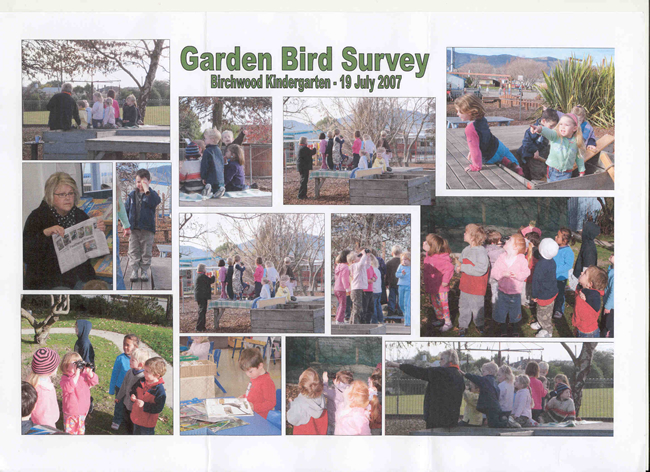 |
| Birchwood Kindergarten display illustrating teachers and children taking part in the garden bird survey. |
Newbury School, an Enviroschool in Palmerston North: A class of 23 children did the garden bird survey in small groups. Teacher Bud Christensen said, “The children in my class really enjoyed doing the bird survey ... It was a very useful exercise as the children learnt how to identify a small variety of birds in our native garden. We studied birds as part of our Māori language unit on Tane Mahuta – The God of the Forest. The children studied birds in class before they went outside to survey our garden.” Later she added, "Great news - while doing PE one afternoon we heard the sound of a tui singing. We stopped to listen and sure enough there it was fluttering, as they do, high up in the clear blue sky above our heads! This is the very first time we have spotted a tui in our school grounds. We feel very excited about it.”
Lake Rotoma School near Rotorua: 12 children (5–6 years old) participated in the survey. Teacher Susan Anderson wrote, “I think there would have been many more birds if the children had not been so keen to observe them. It is very hard to convince 5 and 6 year olds to be quiet for any length of time”. It is wonderful to see such young children involved in the survey.
Westmount School, an independent Year 2–6 school in Tauranga: The whole school (12 students) participated in the survey, completing one sheet for the school grounds and one from each child carrying out a survey at home as part of their homework. Teacher Susan Jones wrote, “We are very much into environmental education and your survey has fitted in perfectly with our study focus this term – flight – and … has been of great benefit to the children, as their ability to identify different bird types and flight patterns has improved. We have also graphed the results as part of maths. The children are now looking forward to seeing your 2007 results on the website … so we can compare the results with our graphs.”
Pigeon Mountain School, Howick, Auckland: The Principal, Ginty Bigwood, sent forms home with the pupils, with the following note; “Dear parents. This is a wonderful opportunity to engage your child in meaningful learning. Most of the students at Pigeon Mountain Primary School are very aware of their environment and it would be great to involve them in a wider community focus. Please think about making a time to work with your child to complete this bird count and appreciate the world around you.” Forty-eight forms were returned, including one from the Principal!
Kadimah College, Auckland: Two classes participated in the survey (one class of 8–9 year olds in Year 4, and another class of 9–10 year olds in Year 5). The Year 4 pupils did the survey individually at home, and the Year 5 pupils did one survey as a class exercise in a local park and then individual surveys at home.
Christian Renewal School, Whangarei: Twenty-two 11–12 year olds did the survey at home. Teacher Graham Elsmore wrote, “The class learned a large amount about the various bird species found locally and generally found it most interesting.”
List of schools participating in the bird survey (in alphabetical order)
- Ashburton Borough School, Ashburton (8 children): whole class at school
- Beryl McCoombs KidsFirst, Christchurch (2 adults, 30 children): whole class at school
- Birchwood Kindergarten, Stoke, Nelson (3 adults, 45 children): whole class at school
- Catlins Area School, Owaka (1 adult, 22 children): whole class at school
- Cherry’s Early Learning Centre, Christchurch (1 adult, ? children): whole class at school
- Christian Renewal School, Whangarei (22 children, 11–12 yrs old): homework (at home)
- Collingwood Area School, Collingwood (8 children, 10–11 yrs old): groups at school
- East Taieri School, Mosgiel (1 adult, 24 children, 6–7 yrs old): whole class at school
- Ellesmere College, Leeston (23 children, 13–14 yrs old): homework (at home)
- Freemans Bay School, Auckland (10 children, 7–11 yrs old): individually at school
- Halswell School, Christchurch (8 children, 11–12 yrs old): homework (at home)
- Hurunui College, Hawarden (4 children, 10–11 yrs old): homework (at home)
- Kadimah College, Auck (21 children, 8–10 yrs old): class in park plus homework (at home)
- Lake Rotoma Primary School, Rotorua (12 children, 5–6 yrs old): whole class at school
- Mt Aspiring College, Wanaka: homework (one at school, rest at home)
- Murchison Area School, Murchison (1 adult, 5 children): whole class at school
- Newbury School, Palmerston North (23 children, Room 3): whole class at school
- Noku Te Ao Early Childhood Centre, Christchurch (1 adult, 4 children): whole class at school
- North New Brighton KidsFirst, Christchurch (1 adult, 13 children): whole class at school
- Opoho School, Dunedin (1 adult, 6 children): whole class at school
- Oromahoe School, Kerikeri (1 adult): teacher at school
- Pigeon Mountain School, Auckland (1 adult, 48 children, 5–11 yrs old): homework (at home)
- St Andrews College, Chch (37 children, 11–13 yrs old): homework (2 at school, rest at home)
- Westmount School, Tauranga (11 children, Yrs 2–6): whole class at school plus homework (at home)
Exceptional records
The highest number of birds seen at one time was 3500 starlings, in a gum plantation. The second highest was 500 spotted shags at Hakatere Huts lagoon. Both of these records were excluded from subsequent analyses because they are extremes, not typical garden situations. The highest number of each species recorded in home gardens, in decreasing order, were 400 starlings, 200 house sparrows, 200 silvereyes, 150 greenfinches, 100 rock pigeons, 48 goldfinches, 48 tui, 45 bellbirds, 40 blackbirds, 40 chaffinches, 40 mynas, 40 mallards, 36 song thrushes, 35 spotted doves, 30 pheasants, 30 dunnocks, 27 yellowhammers, 24 fantails, 23 kereru (kukupa), 22 pukeko, 20 magpies, 17 kaka, 15 sulphur-crested cockatoos, 12 grey warblers, 12 eastern rosellas, and 11 redpolls. However, these numbers are exceptional. The mean (and median) number of each species was much lower.
Unusual garden birds included falcon (5 records), red-crowned kakariki (4), banded rail (3), robin (2), rifleman (1), whitehead (1), fernbird (1), and saddleback (1). Herb Christophers from Silverstream wrote, "I’ve seen falcon from my bed! – with freshly caught tui in talons!” The rifleman was seen by Russell Mason (Pounawea), the whitehead by Len Newman (near Lake Rotoehu), and the fernbird by Noel Burr (near Westport). Lisa and Neil Crosse and their four children heard the saddleback calling in Bushy Park next door to where they lived at the time. Lisa said, “It was a lovely opportunity to be living somewhere where we could see and hear birds which are not commonly seen in other areas.”
Acknowledgements
We thank the 2000+ people who participated in the survey. Various newspapers around the country promoted the survey, but especially The Press, Ashburton Guardian, and Dannevirke News, which printed survey forms. Karen Scott created the web page. Mark Fuglestad designed the web entry form and extracted the data that were entered. Jean Pringle and Barbara Spurr helped open mail. Andrea Airey, Kate Alfeld, Chris Berg, Tom Fraser, Helena Lumsden, Renske Terhurne, Kevin Tranter, Louise Van der Salm, and Wendy Weller assisted with data entry. Forest & Bird and the New Zealand Ornithological Society promoted the survey to their members. The Royal Society of New Zealand provided funding and helped promote the survey to science teachers.

